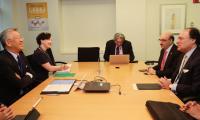Though there is a perceptible shift in mood after every act of violence we get to know about, the recent incidents of violence against women in this country have sparked fury – and rightly so. Unfortunately, such fury is usually short-lived and people move on with their routine lives after a couple of condemnations and protests.
Here we will not discuss details about the types and nature of these crimes, neither will we enumerate what happened when, where, and against whom. Such matters have become fodder for social media now and nearly everyone knows about them. As an educationist and media professional, I would like to discuss the role of education and the media in shaping individuals and societies that become violent against women. Not just in Pakistan, in other countries too there are rampant incidents of violence against women – domestic violence, as well as violence against girls. Essentially, it is the failure of education and training from childhood to adulthood.
Of course, there are exceptional cases in which even the best education and training also fail to nurture a calm, composed, and responsible person. But overall, there has to be explicit focus in education and the media on reducing aggression. Such tendencies of aggression and violence in men are both by nature and nurture, though there is no universal agreement about it among educationists and psychologists. By instinct, at times people react aggressively and violently; and the entire exercise of education and training individuals has a lot to do with controlling our aggression so that we contain our impulses and instincts and do not become violent.
Since the modern state controls education in most countries, there is a tendency to promote in textbooks heroes who were aggressive, masculine, patriarchal, and violent to achieve their individual, national, or religious goals. The list of aggressive and patriarchal heroes is long as opposed to those who were feminine, gentle or humble. Glorification of violence in society through education and the media is supposed to serve cultural, nationalistic, patriotic, and religious purposes. Culturally speaking, from tribal and feudal to industrial and post-industrial societies, aggression and violence is valued as a masculine trait; and this promotes patriarchy.
Looking at Pakistan, across provinces we see a common streak of masculinity and patriarchy that cuts across the class divide. A male child is culturally trained to be aggressive in tribal and feudal societies which take pride in their violent tendencies. The male child living in the industrial age of the 20th century received a constant feed of aggressive and violent behaviour from cinema. From the movie ‘The Birth of a Nation’ of the early 20th century and the westerns of John Wayne to spaghetti westerns of Clint Eastwood, down to the extremely gory and violent movies of Tarantino, cinema exposed generation after generation to aggression and violence.
In Pakistan, from Bashira and Maula Jutt to various Gujjars and Jaggas, there was a steady stream of aggression and violence that shaped our national cinema. Though PTV led by its founding father, Aslam Azhar, did try to expose Pakistanis to cultural and literary masterpieces, TV under General Zia promoted masculinity and patriarchy. From the dramatization of pseudohistory novels by Naseem Hijazi invoking Muslim warriors of yore to the recent craze for Ertugrul, you will hardly find dramas that portray authors, poets, scientists, or thinkers. The glory is supposed to be in fighting and praise is due to the warriors alone.
In the age of information technology, the situation is no better. Now a child (boy and girl), right from infancy, is glued to computer and video games that are mostly violent. Physical violence – be it for aggression or defence – becomes an integral part of most of these games. Unfortunately, most parents make no effort to keep their infants and children away from these aggressive, mostly masculine, and violent games. Even a couple of years’ old infants throw tantrums when a gadget is taken away.
Then there is a significant role that states play in promoting cultural and masculine superiority among children. First, the state identifies masculine characters from history – both national and religious – and fills textbooks with them. Most countries have just founding fathers, not mothers. They have a father of the nation, again without a mother. In Pakistan, in fact even those women who commanded the respect of the people and received titles of veneration such as ‘Madar-e-Millat’ (Fatima Jinnah), ‘Madar-e-Jamhuriat’ (Nusrat Bhutto), Dukhtar-e-Mashriq (Benazir Bhutto), all became victims of acrimonious campaigns. In the 21st century, our heroines such as Malala Yousafzai and Sharmeen Obaid are facing the same aggression.
The world’s youngest Nobel laureate, Malala Yousufzai, may be a much-loved name around the world but a so-called head of a federation of private schools in Pakistan, first writes a book ‘I am not Malala’ and tries to malign her. The book was launched nowhere else but at the National Press Club in Islamabad in 2015. Then the same head of the federation which claims to represent thousands of private schools in Pakistan celebrates Anti-Malala Day and releases an anti-Malala documentary movie with the same title ‘I am not Malala’, in July 2021.
A senior paramilitary officer in Sindh mocks Sharmeen Obaid-Chinoy publicly and derides the first Oscar award a Pakistani won. He makes fun of ‘just three cases of acid throwing on women in Pakistan’ as opposed to ‘hundreds’ in the UK.
These people are not reprimanded for these views. Nobody initiates a case of hate speech, and the courts too look the other way. But this is a country where even a prime minister gets away with his bizarre remarks that he later says were quoted ‘out of context’.
So, what is to be done? There has to be some rethinking at the state level. All men including senior officials in government and state machinery badly need some reeducation in controlling their aggression against women; they need training courses to tame their masculinity. Through education and media, an effective campaign against patriarchy is the need of the hour. All male children need education that explicitly and repeatedly teaches them respect for girls and women. There should be no glorification of honour and violence in textbooks be it in the name culture, nationalism, patriotism, or religion.
Of course, there are myriad causes of violence against women and there is a plethora of academic literature and research on this topic. A brief article cannot cover all aspects of such aggression and violence and it does not claim to be a comprehensive analysis of the problem. But at least a couple of features in most such violence are common and they include excessive exposure to aggressive acts and glorification of masculinity which does not treat women as equal citizens or even respectable human beings.
Patriarchal behaviour is one of the root causes of violence against women and a society needs to counter it sooner or later, even if we have to ditch or downplay our so-called patriarchal heroes. We need to alter the entire focus of education and media to promote decent behaviour towards all, especially women.
The writer holds a PhD from the University of Birmingham, UK and works in Islamabad.
Email: mnazir1964@yahoo.co.uk
India uses Afghanistan as a backstage area to carry out terrorist attacks against Pakistan
Another report by the Pakistan Institute of Peace Studies states that 78 per cent of attacks have been carried out by...
Pakistan stands at the forefront of this crisis, generating a staggering 3.3 million tonnes of plastic waste annually
Today, a total of 11,000 children are attending Daanish schools in Punjab
The emotional instability of parents inculcates a range of psychological issues in children
The current way of dealing with the environment and climate change is no longer adequate







